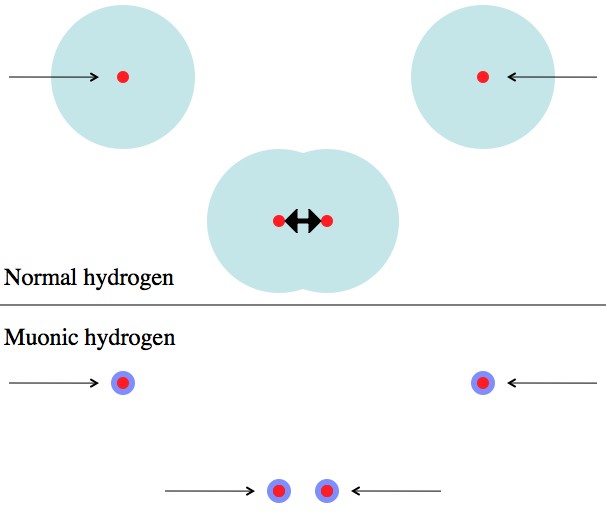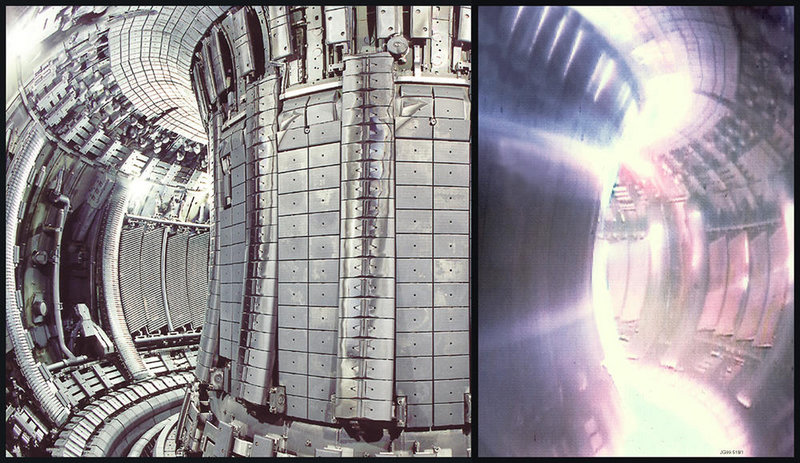Physicist: In a nutshell, fusion is about fusing small atoms, specifically hydrogen, together to form larger atoms, specifically helium. In the processes a lot of energy is released. However, pressing hydrogen together hard enough to fuse it is very difficult, especially considering that the more you succeed, the bigger an explosion you’ll have.
Cold fusion, means doing this in a controlled, consistent way on a small scale, like a power plant, as opposed to something like a bomb.
The energy associated with two like charges is inversely proportional to their distance. That is, if you bring two charges a certain distance, D, apart it’ll take X energy. To half that distance to D/2 will take 2X energy, to half that again to D/4 would take 4X energy, and so on.
Protons (the important players) are so small that you can keep halfing the distance for a long time, so the energy it takes to bring them together is huge. However, if they get close enough the nuclear strong force kicks in, overwhelms the electric force, and slams them together (releasing far more energy than initially went into forcing them together).
The only way to get them that close is to get them moving really fast. Fast enough, and with enough energy, that by the time their mutual electric repulsion has had a chance to throw them apart, they’ve come close enough for the strong force to work it’s magic. The best way to get protons (ionized hydrogen) to move that fast is to heat it (heat is random movement, and a lot of heat is fast random movement). In order to get protons moving fast enough requires temperatures in excess of at least 5,000,000°C. However, at temperatures (and speeds) like that things tend to fly apart immediately, so you need to find some way of keeping the pressure very high to keep the gasses in the same place long enough to react. By comparison, the hottest that the center of a TNT explosion can get is several thousand degrees celcius.
Unfortunately, the pressures and temperatures involved are much, much higher than can be contained with any material known. I mean, normally you need to park a star on it to keep the reaction contained and active. There have been some tricks attempted to get around these difficulties.
“Muonic hydrogen” allows the hydrogen to get closer together before the repulsive forces start. When a proton (positive charge) has an electron (negative charge) around it, the overall charge outside of the electron shell is zero. This is called “shielding”. But, if you bring the protons closer together than the size of their electron shells, their charges are no longer shielded from each other, and they repel. Muons are like a heavy, unstable version of electrons. One effect of their larger mass is that they form a much smaller shell around the proton, allowing the protons to get much closer together before they start to repel. Because they can “sneak up on each other”, it takes less energy to bring the protons together. Unfortunately, muons only exist for a few millions of a second. In that time, they need to be created, slowed down (the creation event is pretty energetic), paired to a proton to form muonic hydrogen, and then slammed into another similarly prepared muonic hydrogen atom.

The negative charges in orbit around a proton "shield" the proton's positive charges from each other. By orbiting tighter around the proton, muons allow the protons to stay shielded from each other to much shorter distances.
“Magnetic containment” gets around the whole “no material can contain the reaction problem” by getting rid of the material (magnetic fields aren’t made of “stuff”). This seems to be the best hope for cold fusion.

ITER in France uses magnetic fields to contain a fusion reaction. That glow isn't the reaction. The reaction actually happens in a ring that runs through the middle of the room.
The only “efficient” fusion ever attained on Earth has been in the middle of hydrogen bombs, where the fusion reaction is contained by being sandwiched between several fission explosions (several atomic bombs).
With great effort, and tremendous amounts of energy (for magnets, and heating, and whatnot), you can get a little bit of fusion. However, the heat energy generated by that fusion doesn’t come close to offsetting the energy that went into getting the fusion to work in the first place.
In dark contrast, you can easily run drills and oil refineries dozens of times over on the energy from the oil they produce.







What about forcing a neutron into a nucleus? What makes extra neutrons “stick”?
I was trying to steer clear of neutrons. They’re just one more level of complicated.
So, generally, the fusion fuel isn’t just hydrogen, it’s deuterium, tritium, or helium 3 (proton/neutron, proton/neutron/neutron, or proton/proton/neutron). For very obscure reasons, they’re easier to fuse.
You can get individual neutrons into a nucleus “for free” since they don’t have any charge to repel them. Once there they stick because they are also subject to the strong force.
Fusing a neutron into an atom should release an amount of energy comparable to what you get fusing a proton in. However, there is a question of scale.
If you want a lot of neutrons, you’d need to carefully exhaust some radioactive element that releases neutron radiation, which is dangerous, inefficient, and slow. Not to mention the fact that neutrons are hard to contain, and have a half-life of around 15 minutes.
On the other hand, if you want 1 kg of hydrogen, all you need is 9 kg of water, and a little electricity. Plus, you can store hydrogen forever.
How does Inertial Electrostatic Confinement and the Farnsworth Fusor compare to the approach used by ITER?
http://en.wikipedia.org/wiki/Inertial_electrostatic_confinement
Pingback: Sains di Balik Game: Senjata Berbasis Fisika Quantum Lab Black Mesa (Half Life) | Log Harian si AW
Pingback: Q: Using modern technology, are we any closer to turning lead into gold than alchemists were hundreds of years ago? | Ask a Mathematician / Ask a Physicist
What is the effect of ultra high temperature on the positive charge proton of Nucleous forces. If we appropriately known it, we may find the substitute of it, like radiation or high energy Gamma rays and can start nuclear fusion and it will be called cold nuclear fusion.